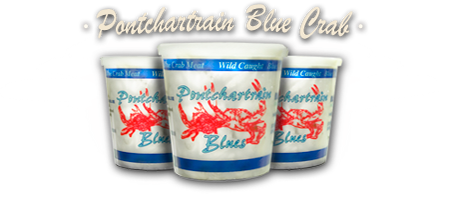FAQ
Frequently Asked Questions
- Who are we?
Pontchartrain Blue Crab Inc is a seafood processor, importer and exporter with a primary focus on top quality crab products. It is our mission to offer our customers superior quality and consistent supply of the best seafood products available. With the launch of our new website, we are moving from primarily a wholesale supplier to a wholesale and retail supplier.
- Is PBC crab meat fully cooked?
Yes, both fresh and pasteurized crab meat has been fully cooked and is ready to eat. Many people choose to use the meat as part of a prepared dish or recipe. When using PBC pasteurized crab meat, please use caution opening the containers, making sure to be careful around the metal ring. The container is NOT intended to be used as a serving dish.
- Why do I sometimes find shells in the crabmeat?
The crab is an intricate and fascinating animal. Crab meat is tucked into several small compartments separated by a thin shell or cartilage. Our hand pickers are trained to remove as much shell as possible, but some shell fragments are difficult to remove because they are very thin and transparent. After picking, the crab meat is put through a thorough inspection to eliminate any remaining shell. Although we aim to eliminate 100% of the shell, we are limited by particle size constraints and by the amount of time the meat can be exposed to higher temperatures.
- What is the proper way to handle crab meat?
Proper handling by the manufacturer is the most critical factor to establishing good quality shelf life of pasteurized crab meat. Shelf life is the storage time that a product has between the time of production and the time when it is no longer suitable for consumption. Processors must follow a stringent set of guidelines and record each step of production to create a product that will offer a maximum shelf life to home consumers, retailers, and food service facilities. Our process is inspected & meets HACCP standards.
Storage temperature is a crucial factor in maintaining shelf life. Product that has undergone the pasteurization process and is stored between 32-35ºF will have a shelf life of up to one year. Buyers and users of large quantities of pasteurized crab meat need to maintain cool rooms at 32-35ºF and rotate the inventory so that the older meat is used first. Limited short-duration rises in cool room temperature (though not more than one hour at a time), even as high as 40ºF, are not critical. However, long-term storage above 38°F will shorten the projected shelf life of pasteurized crabmeat.
In addition to a shortened shelf life, long-term storage of pasteurized crab meat may minutely change the flavor, color, and texture of the product. Users of pasteurized crabmeat should realize that these changes are more noticeable with longer-term storage and increase more rapidly with higher temperatures.
- How long does the product last in a home refrigerator, unopened and opened?
Most of the same principles above apply to home use, but home consumers should realize that the majority of home refrigerators do not maintain a temperature that would be considered adequate for long-term storage of crabmeat. Therefore, unopened pasteurized crab meat being held in home refrigerators should be used within 60 days of the time it was purchased. Once the container has been opened, the product should be used within 5 days and must be kept refrigerated.
- Can I freeze Pontchartrain Blue Crab Inc. pasteurized products?
Yes, you can. If storage time longer than 60 days is required, then freezing of the product is recommended; however, the consumer needs to be aware that freezing will also change the flavor and texture of the crab meat. Freezing is a safe method for home preservation of crab meat, but should be used only when longer than recommended time is required between purchase and use. Store crab meat in home freezers at 10ºF or below for up to 3 months. If your freezer will not maintain 10ºF, then shorter shelf life will result. The plastic containers are susceptible to cracking. You may wish to remove the meat and use an airtight freezer bag instead. When using a freezer bag, expel all air and flatten the bag as much as possible so that the meat lies in a thin layer.
- What are the grades of crabmeat?
Colossal and Jumbo Lump
Colossal and Jumbo Lump are prized for their impressive size, bright white color and exquisite taste. Colossal and jumbo lump consist of the two large muscles connected to the swimming fins of the crab; colossal simply comes from larger crabs than jumbo lump. Colossal and jumbo lump should never be broken up for a recipe; they are best used in upscale cocktail presentations or in sautés, where the size of the lumps can really shine.Super Lump
Perfect for making dishes where crab is the star. Super lump crab meat’s sweet flavor and large pieces give any crab dish a dash of panache. Super lump is a combination of broken jumbo lumps and whole body meat extracted from the shell. The grade allows for even distribution of crab meat throughout the recipe, with large enough pieces of meat to shine through the rest of the ingredients. Try super lump crab meat in crab cakes, as a pasta topping, scampi or a ceviche.Backfin
Backfin is a blend of broken pieces of jumbo lump and special grade crab meat. It is perfect for use in crab cakes, dips, salads, and casseroles. Backfin makes a beautiful presentation when stuffing fish, chicken, vegetables, or seafood.Special
Often considered the most versatile grade for the widest range of recipes, special crab meat consists of the smaller pieces of white meat from the body of the crab. Perfect for crab cakes, salads, quesadillas, wraps, soups, and crab balls.Claw Meat
Picked from the swimming fins of the crab, claw meat is a brown meat with a stronger flavor profile. Its stronger flavor profile makes claw meat ideal for dishes with heavy sauces or in dips and soups, as the flavor of the crab still comes through.



